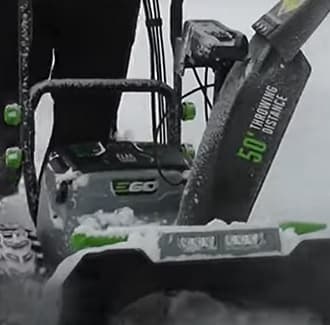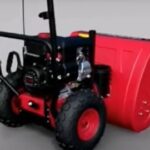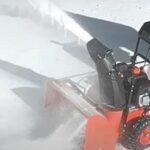As an Amazon Associate, this site earns commissions from qualifying purchases. For more information click here.
A snow blower goes through a lot especially when clearing packed snow and ice. This is why a lot of people ask if a snow blower can overheat. Gas powered models uses fuel obviously and have an engine. So do you need to worry about overheating while clearing your driveway?
A snow blower can overheat if animals build nests inside it or the fuel is too lean. Apart from these two scenarios, it is rare for snow blowers to overheat because of their air cooled engines. If the engine stops running when it’s hot, this is likely due to a damaged component than extreme heat.
What Causes Snow Blowers to Overheat?
The most common causes are mice building nests inside the fins or too much air in the engine. But it is not something to really worry about since both are preventable.
Lean fuel. You have probably heard that a lean fuel to air mix causes an engine to run hotter. In a rich mix, the fuel absorbs the heat. In a lean mix there is not enough fuel to do this, causing the temperature too rise. At least that is how it was back then.
Today’s small engines can run on lean fuel fine. If your snow blower feels too hot when you run it lean, you can adjust the carburetor settings to fine tune this.
While snow blowers can overheat, it is rarer compared to other small engines. As will be explained next, this has to do with the way snow blowers are built and run.
Animal nests. Mice are known to nest inside snow blower fins, and this can lead to engine overheating. This can also happen if the fins get clogged with leaves or grass. For example, if you keep your snow blower outdoors without cover, leaves and other debris are going to collect there.
Keep the fins free from debris. Put a tarp on the snow blower if you have to leave it outside. Regular cleaning can prevent this problem from occurring.
Do Snow Blowers Have Overheat Protection?

An engine usually overheats due to rising temperature and insufficient ventilation. Think of a gas chainsaw running at full power at high noon. If you keep using it nonstop, the engine will eventually give out. The same goes for other small engines.
This is unlikely to happen to snow blowers like the 250cc Power Smart BS26. For one, snow blowers run in cold or freezing weather. Compared to a chainsaw that has to deal with the sun, snow blowers run in very cool temperature. This helps keep the engine from running too hot even with continuous use.
Second, snow blowers have fans and vents. As long as the machine is properly tuned, these components will keep the machine from getting too hot. These machines not only run in cold weather, but they also have several cooling mechanisms in place.
These cooling finis are also designed to withstand clogging. There will be times when snow collects in the area around the fins. But if you have a quality machine this is not going to affect performance. You should clean it off when you are done, but it should not slow you down.
In fact, the snow will bring the temperature down even more. If you check the engine is likely to run cooler than it did before.
There are some similarities among small engines, but those on snow blowers benefit from the environment they are used in. Air cooled engines also cool down quickly without any load or idle. This is another reason why overheating is unlikely.
How Long Can You Run a Snow Blower before It Gets Hot?
When you turn on a snow blower, it reaches maximum temperature after 10 minutes or so. It is not going to get any hotter unlike other engines. So you can run it for as long as needed.
Assuming your snow blower is properly tuned, you can run it until you are done. Some operators like to cool the engine every hour. You can give the snow blower a few minutes break when the tank is empty. But this is not necessary.
Snow blowers use air cooled engines, and these do not get as hot as other small engines. If you are worried about the heat, get an IR heat gun. Our pick is the Klein Tools IR1 Infrared Thermometer, as it is accurate and easy to use. Run your snow blower for an hour and check the sump temperature. It will likely be lower than you might expect.
Another way is to remove the dipstick after using the machine. Wipe your hand with it and you would be surprised that it is just warm, not hot. That tells you the engine is not overheating.
If you have an old snow blower, let it idle for half a minute after you are done. The snow blower probably does not need it, but a safety precaution is good practice for older models. Idling is most suitable if you just ran the engine at full throttle for a long time.
Why Does My Snow Blower Stop When it Gets Hot?
If you run a snow blower in wet conditions and it is in good condition, there should be no problems. But why is it that sometimes snow blowers lose power when it gets hot?
As explained earlier, snow blowers rarely overheat because of the way they are built. But there are cases when the machine just stops when it gets hot. We are not talking about overheating here, just hot. What could be causing this?
Let us look at the most common reasons why this happens and how to fix it.
Valve Lash Needs Adjustment
The valves let fuel get in the engine and expel used fuel. If the valve opening and closing is off, this could lead to a leaner mixture and drive up the temperature. Older snow blowers are most likely to be affected by this. Adjusting the valves is the solution.
Take off the valve cover and spark plug. You have to take a look at the valve springs and to do this, rotate the engine first.
Put a pen in the cylinder so it is on the piston crown.. Turn the engine until the pen is as far from the cylinder as possible. The springs should be unloaded and the valves closed.
Put a feeler gauge in the middle of the rocker and the valve. Make adjustments if the gauge is too loose or tight. To do this, turn the lock nut counterclockwise.
Adjust the adjuster screw while observing the changes in the gauge. When the tightness level is correct, lock the nut. Put the valve cover back in place.
Damaged Armature (Coil)
The armature produces voltage as the flywheel rotates. This voltage goes into the spark plug which ignites the engine. This can fail due to wear and tear or overheating. If the engine is clogged with mice nest for example, this can overload the armature quickly.
You can use a coil spark tester to check if it is indeed damaged. If so, you have to replace it right away. To replace the armature, take the blower housing off. Next, take out the armature fasteners and control wire.
Remove the armature and connect the control to your new armature and put the fasteners back. Do not tighten them yet. Put a feeler gauge in the middle of the flywheel and coil. Set the coil towards the flywheel and secure the fasteners. Put everything back and your snow blower is ready.
Spark Plug Defect
A faulty spark plug causes all kinds of problems. If it is not working, your snow blower will stall the moment it heats up. You can use a spark plug tester to check if it is working. If the spark plug is damaged, get a replacement. Consult your owner’s manual for the right spark plug type to use.

I love the outdoors and all the tools for maintaining gardens, yards and lawns. The only thing I am more passionate about is sharing what I know about garden and outdoor equipment.


